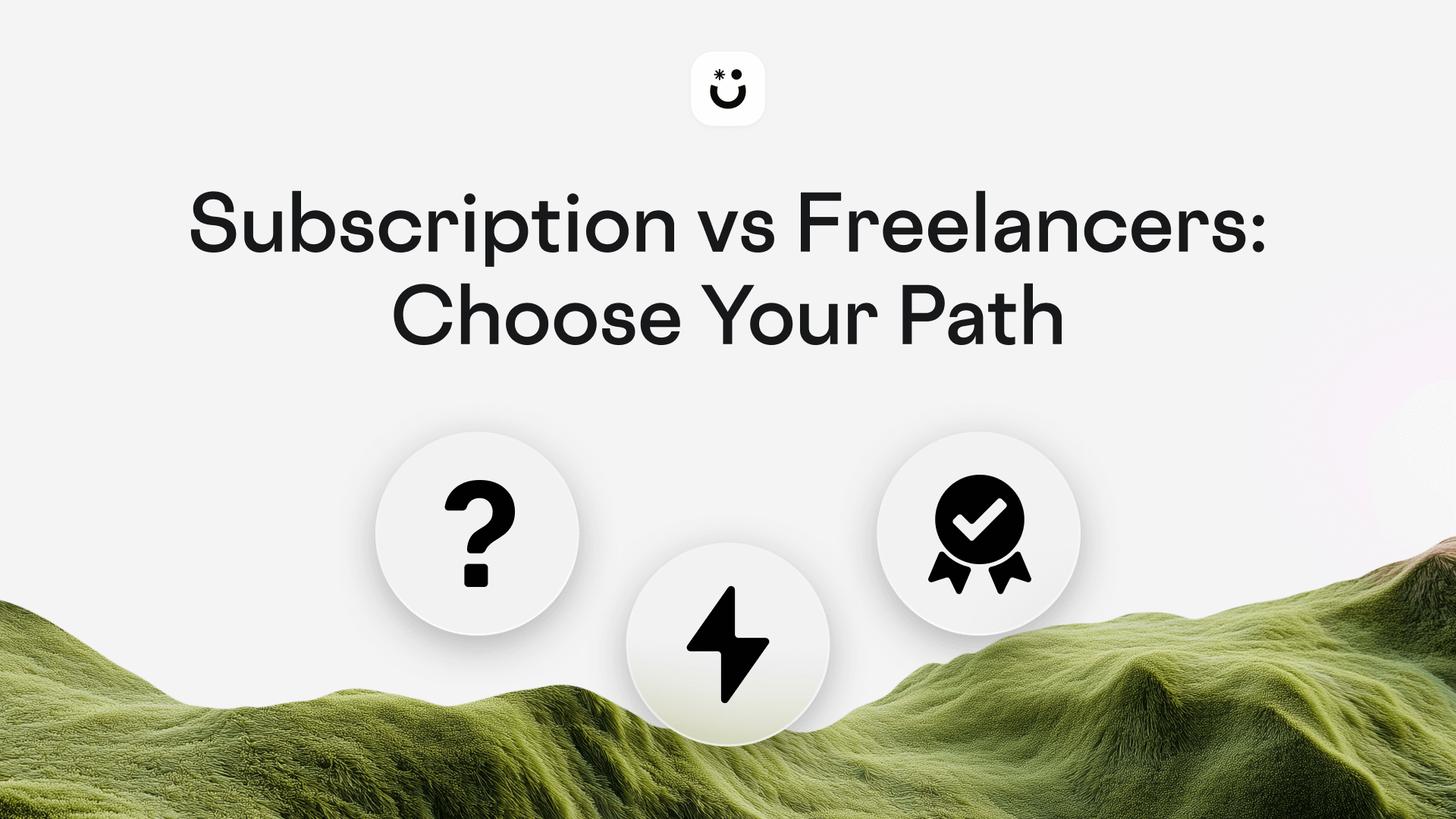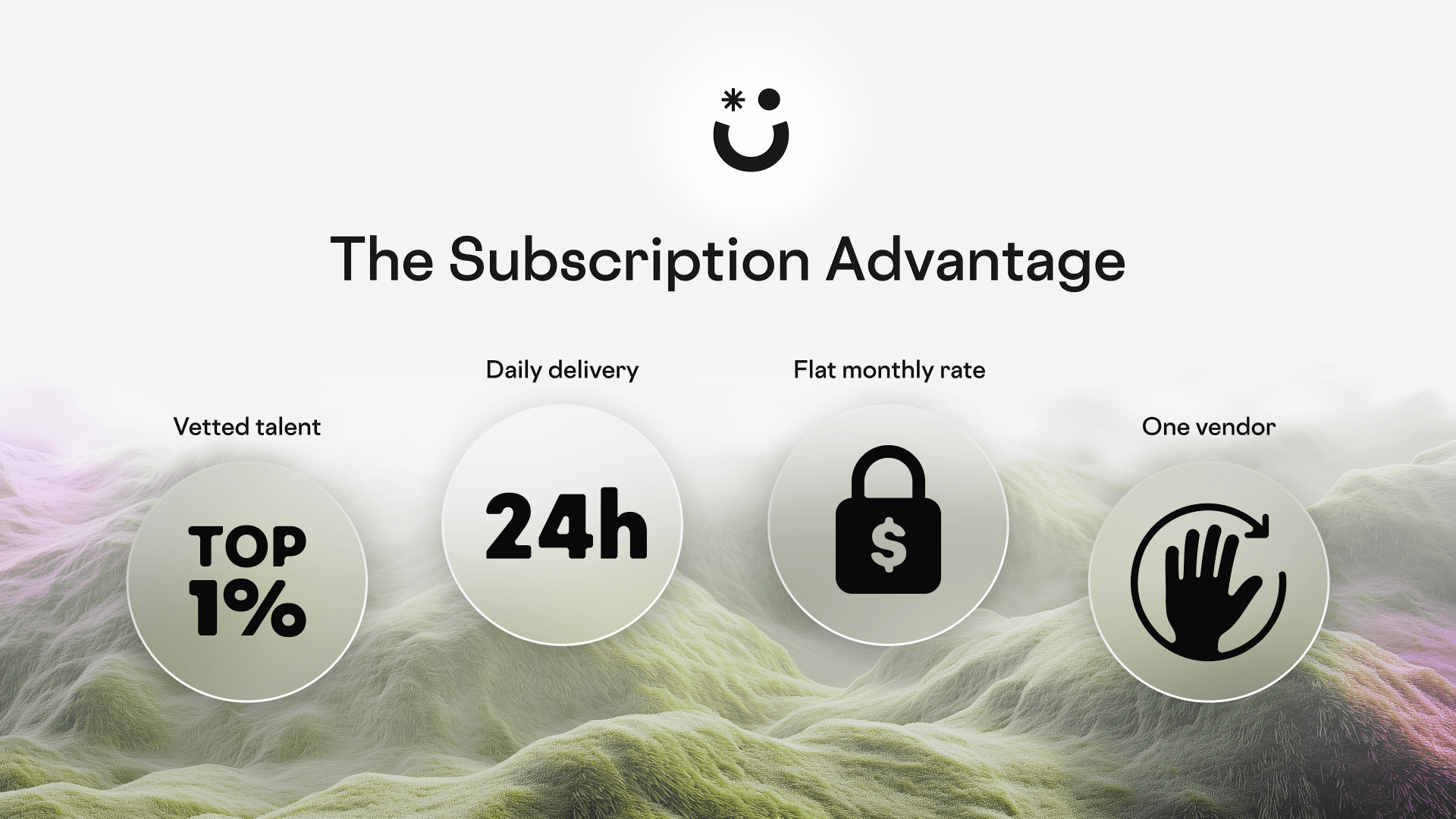Subscription Talent vs Freelance Platforms: What Business Leaders Need to Know


The problem with traditional freelancing for product, design, and growth
The freelance economy has experienced explosive growth over the past few years. Between 2022 and 2024, U.S. businesses hiring freelancers surged by 260%. Today, 28% of U.S. knowledge workers freelance, generating $1.5 trillion in earnings.
For enterprises, this shift seemed like a viable solution as well. Tap specialized talent without full-time commitments, scale teams flexibly, and control costs.
But there's a catch.

Enterprise companies that use freelancers now manage an average of 15 contractors, representing approximately 8% of their workforce. That's essentially a small pod to coordinate, vet, and manage. And the hidden costs are stacking up.
Hidden costs plague the freelance model. Without streamlined systems, businesses can waste hundreds of hours annually on freelance payroll and HR tasks. One AllWork analysis found that companies spend a significant amount of internal time just processing payments and managing work completion. Then there's the legal risk, such as fines for worker misclassification that can amount to thousands of dollars, as well as new laws.
Coordination overhead multiplies with scale. Hiring one freelancer for a logo? Manageable. Coordinating five freelancers across design, development, and copywriting for a product launch? That's project management hell. Each person has their own communication style, time zone, availability conflicts, and other clients competing for their attention. You become the air traffic controller, not the strategist.
Speed variability kills momentum. Even on fast platforms, finding and hiring a freelancer takes approximately 3 days on average, according to Upwork’s estimation. For specialized roles, it can stretch to weeks, as SHRM estimates a 44-day time-to-fill in 2025 for full-time positions. Once hired, freelancers juggling multiple clients may deliver inconsistently. Your urgent landing page competes with someone else's brand refresh. The result? Launch delays that cost real revenue.
Quality assurance is a gamble. Open freelance marketplaces have millions of profiles. Upwork alone connects clients to a pool of over 12 million. Anyone can sign up. While top freelancers deliver exceptional work, finding them means sorting through proposals, checking portfolios, running test projects, and hoping reviews aren't inflated.
This isn't to say freelancing is broken. For specific, isolated tasks such as a one-time illustration, a niche database optimization, or a quick translation, hiring a freelancer makes perfect sense. However, as enterprise, startup, and scaleup teams expand their flexible talent usage, the traditional freelance marketplace model may begin to show strain. Companies require a distinct approach for ongoing, multi-skilled projects where speed and consistency are crucial.
What subscription talent changes for startups and enterprises
Enter the subscription-based talent marketplace. Instead of posting jobs and reviewing bids, you pay a flat monthly fee for on-demand access to vetted talent. Think of it like Uber or Netflix for creative and technical work: unlimited requests, predictable cost, managed delivery.
How it works: You subscribe to a service (like Awesomic's talent matching app) and submit project requests through their platform. An algorithm or account manager matches you with a qualified expert, often within 24 to 48 hours. That person (or team) works on your tasks, delivering updates on a daily or set cadence. Need a designer today and a Webflow developer tomorrow? All can be managed within a subscription. No new contracts, no bidding wars, no coordination chaos.
What makes it different from freelancing:
- Vetted talent pools: Services accept only top performers. Toptal famously screens down to the top 3% of applicants. Awesomic's acceptance rate hovers around 0.82%, meaning only the strongest make it through. You skip the vetting lottery.
- Guaranteed throughput: Many subscription services promise daily progress or specific turnaround times. Awesomic, for instance, delivers updates every 24 business hours on active tasks. Freelancers? There is no guarantee, as they work at their own pace.
- Flat-rate pricing: One monthly bill covers multiple requests and unlimited revisions. No hourly overruns, no surprise invoices for scope changes. Budgeting becomes predictable.
- Multi-skill flexibility: Higher-tier plans often include design, development, and marketing under one roof. Need a logo, then a landing page, then ad creative? All covered. With freelancers, you'd hire three separate people at a minimum.
- Reduced management burden: You submit briefs, review work, and give feedback, but you're not chasing payments, negotiating rates, or onboarding each new person. It's B2B with one touchpoint, not 10 independent touchpoints for each specialist you need.
Why enterprises should care: For product leaders launching features, marketing teams running campaigns, or founders scaling startups, this model addresses the core pain - delivering quality output quickly without incurring internal overhead. You're essentially renting a high-performing team segment without the HR complexity.
Key factors head-to-head: Subscription vs. Freelancers
Let's compare these models on what enterprise teams actually care about.

Speed of onboarding & turnaround
Freelancers: Finding someone takes around 3 days if you're lucky. Specialized roles? Longer. On platforms like Freelancer.com, projects get an average of 41 bids within the first 5 minutes, which sounds fast until you realize you now have 41 proposals to review. First drafts might arrive days or a week later, depending on the freelancer's workload. If revisions are needed or they're juggling other clients, timelines stretch.
Subscription services: Onboarding is near-instant. You sign up, get matched with an expert within 24 to 48 hours, and work starts the next business day. Many services deliver daily progress; Awesomic promises updates every 24 business hours. A task that might take weeks with intermittent freelancer availability can be completed in days with focused attention.
Learn more about how Awesomic created a brand identity for Perseus Defense in 10 days
Quality & talent reliability
Freelancers: Quality can be hit-or-miss. Yes, exceptional freelancers exist. However, finding them in a sea of over 60 million people presents a significant challenge. Each new hire has a learning curve with your brand. And if your freelancer lands a bigger gig or gets sick? You have a single point of failure with no backup.
Subscription services: Talent is curated. They are vetted rigorously, with only top-performing candidates getting in. This means baseline quality is high. Consistency improves because the service can keep the same person on your account or share brand guidelines internally. If someone's unavailable, a qualified replacement steps in seamlessly. You're not relying on one individual's reliability but on an organization with accountability.
Toptal reports that 98% of clients are satisfied after the trial period, suggesting that vetted freelance models are effective. The difference? Subscription services extend this curation to a continuous relationship, not just one hire, and they have an incentive to keep you happy and coming back month after month.
Cost & budget control
Cost and budget are always subjective to a certain extent due to the differences in what constitutes quality, what’s fast, and what the requirements are for each project you’re trying to push through. That said, here’s a simple breakdown.
Freelancers: You pay per project or hour. For sporadic needs, such as one logo every few months, this is a cost-effective solution. Skilled designers may charge $50-$150/hour. Costs can balloon if projects expand or require numerous revisions. Don't forget platform fees and the internal cost of managing payments to multiple people. One analysis found that freelance design work can run $35,000-$85,000 annually after factoring in management overhead and rework.
Subscription services: A flat monthly fee, typically ranging from $1,000 to $5,000, depending on the plan and scope. This covers unlimited requests and revisions. The more you use it, the better the ROI. That same analysis pegged subscription costs at $36,000-$72,000 per year for similar output, which is about 20-40% cheaper on average. Plus, no surprise bills. One monthly invoice simplifies procurement.
Scalability & flexibility
Freelancers: To scale output, hire more freelancers. This takes time (remember, ~3 days per hire) and quality becomes harder to maintain across a larger pool[29]. Scaling down means ending contracts and possibly losing those freelancers if you need them later.
Subscription services: Most let you scale up or down with a click. Need extra design capacity for a holiday push? Add another seat or upgrade tiers. Slow month? Pause or downgrade. The provider handles finding additional talent in the background.
Compliance angle: Rapidly onboarding dozens of contractors may raise HR & Legal red flags. A subscription model shields you from engaging with multiple vendors who handle talent contracts and privacy guidelines. Less misclassification risk.
Management & communication
Freelancers: You're the project manager. You coordinate schedules, review work individually, give feedback, and track deliverables. That's where those "hundreds of hours" go. Tools like Upwork help (time tracking, chat), but you're still playing team lead. If multiple freelancers collaborate, you're the glue.
Subscription services: A unified dashboard or account manager streamlines this. Submit requests, feedback, and revisions in one place. It feels like working with a cohesive team, not disparate individuals. They also tend to offer multiple channels of communication, including email, Slack, or in-app chats.
When to use which: Decision guide for teams

Here’s one way to look at the options at your disposal when it comes to freelancers vs subscription talent.
Use freelancers for:
- One-off or ad-hoc tasks: Need a single banner every few months? Paying monthly for a subscription makes no sense. A freelancer per project is cost-effective.
- Ultra-specialized expertise: Looking for a one-time database optimization expert or a rare niche skill? Find that specific freelancer and engage them directly.
- Tightly scoped projects with flexible timelines: If you have a clear spec, can manage the process, and aren't in a rush, freelancers work fine.
Vet carefully and consider overhead. But for truly minimal needs, freelancing will most likely be a good fit.
Learn more about Awesomic’s 1:1 plan, where we match you with a full-time expert for the particular skills and requirements you need.
Use subscription talent services for:
- Continuous design/dev/marketing needs: Startups with weekly design requests, companies running ongoing campaigns, and product teams iterating features. Subscription talent marketplaces keep the pipeline flowing without re-hiring.
- Multi-faceted projects: Full rebrand? Subscription services handle logo, website redesign, launch videos, and social graphics under one roof, ensuring consistency.
- Rapid growth or tight deadlines: When timelines are aggressive and the scope might expand, guaranteed daily output and easy scaling are key advantages.
- Teams without PM bandwidth: Solo marketers or lean teams often lack the time to manage five freelancers. A subscription is like plugging into a ready team.
- Need for budget predictability: Every enterprise project must adhere to its budget and timeline. Knowing you'll get X output for $Y per month makes planning easier.
Real-world case: E-commerce holiday push
Imagine an e-commerce scale-up preparing for Black Friday. They need a UX refresh, 50 new ad graphics, and an email campaign—all within one month.
Freelancer approach: Post three jobs (designer, developer, copywriter). Wait 3+ days for each hire. Coordinate schedules across three people who've never worked together. Hope they're all available simultaneously and interpret your brand consistently. Likely outcome: some deliverables late, inconsistent quality, and you've spent 20+ hours just managing.
Subscription approach: Submit all requests to your subscription service. They deploy multiple specialists under one plan. You have a single point of contact, receive daily updates, and all deliverables are completed on time. One invoice. Likely results: A Black Friday launch on time, with the bandwidth to actually plan a strategy instead of herding cats.
Disclaimer: Pricing and service details are based on publicly available information as of October 2025 and may change. Actual outcomes can vary. This article is intended for general informational purposes only. All company names and trademarks are the property of their respective owners, used for identification purposes only.
The future: Why subscription models are gaining ground
Freelancing isn't disappearing. Projections indicate that by 2027, 50% of the U.S. workforce will be freelancing. But as more companies rely on flexible talent, they're discovering that managing 8% of their workforce as independent contractors creates new problems.
Subscription talent services offer a middle path: the flexibility of freelancing with the reliability of a team. Companies that adopt these models can innovate faster, with leaner internal teams and more predictable costs. It's about building an extended bench that you can dial up when needed, without the headaches of first-generation freelance marketplaces.
Enterprises, startups, and scaleups that master this model will have an unfair advantage. They'll ship products faster, run campaigns more efficiently, and scale output without scaling headcount.
If you're an enterprise leader or startup founder aiming to boost output without increasing headcount, it might be time to consider a subscription-based talent partner.
One subscription and your hiring problems solved


FAQ

Awesomic is a revolutionary app that matches companies with vetted professionals across 30+ skill sets, from design and development to marketing and product. Based in San Francisco with a global core team, we offer a faster and more flexible alternative to traditional hiring through a subscription-based model. Awesomic delivers high-quality talent on demand, without the delays of recruiting.

We function as a subscription-based service that matches you to top-tier, vetted talent. Submit a project in just a few clicks and start receiving deliverables in as little as 24 hours. Scale your Awesomic plan up or down as your business needs change.

Every Awesomic subscription comes with unlimited revisions. You receive daily progress updates via the app, and you can provide feedback or request iterations as needed. If your project requires a different approach, you can request a talent rematch at any time, at no extra cost. You can also add teammates to collaborate and streamline feedback

A talent marketplace is a platform that utilizes data and intelligent matching algorithms to connect professionals with projects based on their skills, experience, and availability. While often used internally by large companies, Awesomic applies this model at scale, matching vetted global talent to your most critical business needs.

Hiring is time-consuming, expensive, and risky. Awesomic eliminates that problem. We rigorously vet all talent for technical ability, communication, and soft skills, ensuring only senior-level professionals work on your projects. You skip the job posts, interviews, and delays, and get straight to results.

No, Awesomic goes beyond design. While many clients utilize us for branding, UI/UX design, or motion graphics, we also provide vetted talent in no-code web development, product design, marketing, and more. Think of us as an extension of your team. A flexible, high-performing creative partner from planning to execution, whether you're building awesome products or scaling your team.

You can talk directly with your matched talent via the Awesomic app, connect via Slack, email, or schedule video calls. No matter the plan, you’ll receive daily updates in the app for every active task. You can also tag us in for any issues through our in-app customer chat.












